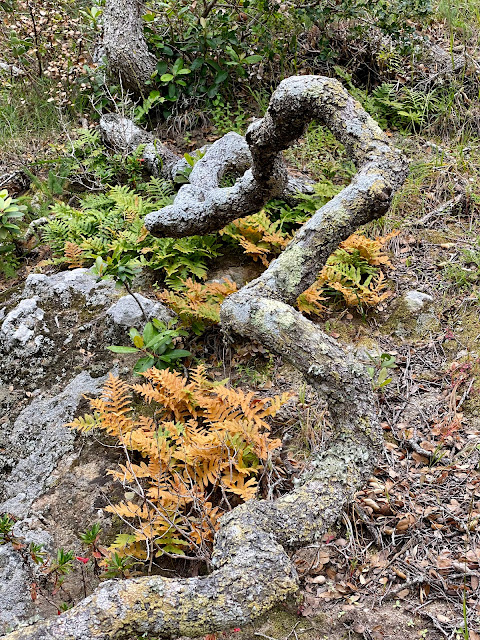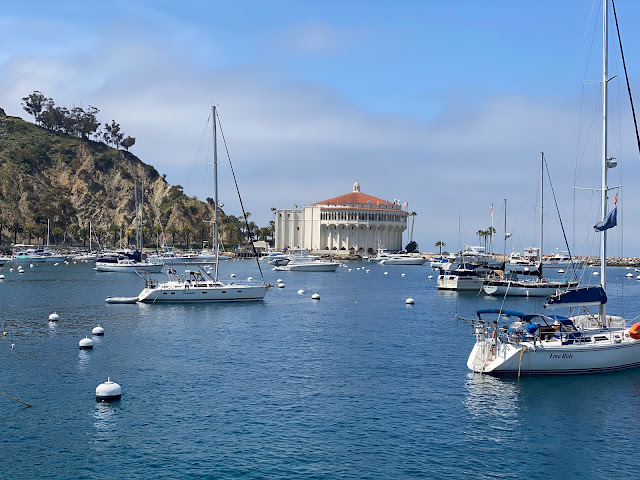We were originally scheduled to visit the California Channel Islands on a National Geographic / Lindblad Expedition in the spring 2020, but the trip was cancelled due to COVID. We were finally able to take the trip this April and were fortunate to travel following an ample rainy season and the wildflowers were at their best. Our little group included me, Scott Borden, SDHS member Ken Blackford, Jan Emming (who some of you may know from his fascinating Facebook tales of living in western Arizona), Scott's sister-in-law Stacy, and her neighbor Pam.
The trip included hiking, diving, kayaking and more, but for Scott, Ken, Jan and me it was about the plants. We became known as the "Botany Group" as we could be found at the back end of every hike, slowly checking out each and every plant.
 |
| Inspiration Point, Anacapa Island |
Anacapa
I'd long wanted to visit Anacapa for the amazing scenery of this five mile long group of three narrow, steep volcanic islands featuring a famous arch and the aptly named Inspiration Point. East Anacapa has an unmanned lighthouse and is home to a large colony of endangered California brown pelicans. It's also home to many other species of birds thanks to the removal of non-native rats just 10 year ago, allowing nesting bird populations to quickly recover on the island.
On our hike walking through the birds it seemed as though the island was a set for the Alfred Hitchcock classic movie, "The Birds." It has the largest breeding colony of western gulls in the world and they were doing just that...courting, breeding, nest building, egg laying, and mostly yelling at the humans in their presence.
 |
| Eroded volcanic arch and cone covered with guano from nesting cormorants and brown pelicans. |
 |
| One of the many iconic views of Anacapa Island. |
 |
| Western gulls were seen everywhere on the island. |
 |
| Cathedral Cove. |
 |
| Western gulls, under and above Giant Coreopsis, Leptosyne gigantea.
The plant is endemic to the Channel Islands. |
 |
| Gulls and California Golden Fields, Lasthenia californica. |
 |
| Lasthenia californica, Golden Fields and blue Phacelia. |
 |
| A pair of gulls and Inspiration Point. The gull on the left has nesting material in its beak. |
Channel Island endemic Malva assurgentiflora.
There were also many non-native Mediterranean mallows on the islands.
 |
| A western gull with an egg. |
 |
| Inspiration Point and the marine layer. |
Santa Cruz
After Anacapa, we stopped at Santa Cruz Island. Scott and I had visited it on a day trip back in 2005 to celebrate my 50th birthday. On that trip I had my first electronic camera and took some great photos, all of which I accidently deleted the next day while trying to learn to use the camera. This time I used an iPhone and backed up to the cloud. We came ashore at Prisoners Harbor and did a short hike, mostly looking for wildflowers, but were fortunate to see an Island Fox and Island Scrub Jay.
 |
| The native Santa Cruz Island fox. This one had a collar on. We saw evidence of them on all of the islands, but other than this one, we only had one other quick glimpse. |
 |
| Drying foliage of Leptosyne gigantea with blue dicks, Dipterostemon capitatus. |
 |
| A massive and gnarled old oak tree. |
 |
| A view of the pier and setting sun. |
Santa Rosa
We spent most of the second day on Santa Rosa Island. We did a 7.5 mile hike to a grove of native Torrey Pines trees. Other than the trees at our San Diego County namesake preserve, this is the only other remnant of these once abundant Southern California trees.
We spent much of the hike observing the plentiful native wildflowers and plants along the way and ate lunch among the Torrey Pines with the marine layer fog blowing through. The trees seemed to grow more densely, have shorter needles, more basal branching, and be a deeper green than their San Diego cousins.
Castilleja affinis, coast paintbrush, showed a lot of variation in colors from yellow and pink to bright red.
Seaside Woolly Sunflower, Eriophyllum staechadifolium, were just coming into bloom.
Views of the hills. Eriophyllum staechadifolium, common yarrow, Artemisia californica, and Vicia (purple Vetch). We were unable to determine if the vetch was native, but there were whole hillsides of it.
Island fox footprints. We saw lots of fox scat, but no foxes on Santa Rosa.
The coast form of our native California poppy is shorter, perennial, and usually yellow with an orange center.
Pinus torreyana, Torrey Pine.
Under the pines.
A river of fallen pine cones.
Viola pedunculata growing under the pines.
Looking much like San Diego, the fog was blowing through the tops of the trees. Black sage in the foreground.
Gnarled old chaparral trunk and California Polypody, Polypodium californicum starting to go summer dormant.
A bit of a surprise was the abundance of Fairy lantern, Calochortus albus, flowers sprinkled along the trail in many places. Unlike most Calochortus, it has downward facing blooms and translucent flowers that capture the light and appear to glow.
Scarlet Monkeyflower, Erythranthe cardinalis.
Red galls on an Manzanita. The galls were fairly common.
Lyonothamnus floribundus s. aspleniifolius, Santa Cruz Island ironwood is found on Santa Rosa, Santa Cruz and San Clemente islands. We found it growing on Santa Rosa in the ravine below the Torrey Pines in what must be a more damp area. Surprisingly, it is a member of the rose family, Rosaceae. The less common Catalina form (Lyonothamnus floribundus) has smoother and undivided leaves.
Purple Owl's Clover, Castilleja exserta. The plants on the islands were often pink with touches of yellow.
We found the uncommon Malacothrix incana, Dandelion, growing on sand dunes near the beach. It used to grow on San Diego beaches, but is no longer found here.
Abronia umbellata, beach sand verbena and Camissoniopsis cheiranthifolia, Beach Evening Primrose.
Eroding beach sandstone cliffs.
Santa Catalina Island
Our last nature stop was the western side of Santa Catalina Island. We did another hike to a scenic lookout and the highlight of the hike was the discovery of countless Calochortus catalinea, Catalina mariposa lily, in full bloom sprinkled along the trail. There were numerous other flowers as well.
Velella velellas or “by-the-wind sailors” were numerous on the beach here. They float on the surface of the ocean and the wind blows them onshore.
The best Dudleyas of the trip were on the west side of Catalina Island. They were plentiful and huge and many were in bloom. These are likely D. Greenei which grows on many of the islands.
Dudleyas and lupines on beach cliffs.
Ever so elegant, Calochortus catalinea, were plentiful and appeared to be in peak bloom.
 Calochortus catalinea showed many variations in color tone and spots.
Calochortus catalinea showed many variations in color tone and spots.
Lycium brevipes var. hassei, Santa Catalina island desert thorn.
Golden Spined Cereus, Bergerocactus emoryi, is somewhat rare in California only growing on San Clemente Island, Catalina, and a couple of places on the San Diego Coast. It is fairly common in Baja.
Encelia californica, Opuntia, and Artemisia californica overlooking Shark Harbor.
Bloomeria crocea, Goldenstar, were blooming among other low growing plants.
Abronia maritima, is an unusual succulent sand verbena that only grows with sea spray. It requires saline water but cannot tolerate fresh water, ocean surf or long dry periods.
Avalon
Our last stop of the trip was at the harbor in Avalon. We spent most of the afternoon walking uphill to the Botanic Garden. We should have taken a cab, but did take one back to town.
The botanic garden is a bit of disappointment, but it did have some nice plants on display, especially island natives, and collections of Euphorbias and Cacti.
Avalon harbor and Casino.
Avalon is know for its unique California style tile.
Euphorbias at the Catalina Botanic Garden.
Wrigley Memorial at the top of the botanic garden.
 All of our Gulls in a row and and ready to go home
All of our Gulls in a row and and ready to go home
Avalon harbor at night




























































Comments
Post a Comment